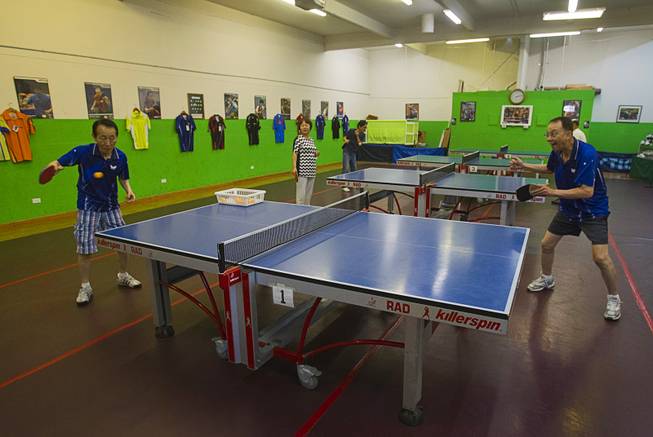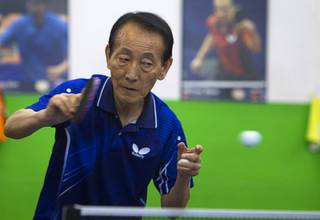
Jong Jin Lee, left, 73, gives a lesson to Sam Lee (not related), 64, at the Nevada Table Tennis Center, 4063 Renate Dr. (Chinatown Mall), Wednesday, June 25, 2014.
Sunday, July 6, 2014 | 2 a.m.
Nestled away in Chinatown, down a back alley amid entrances for Asian markets and a massage parlor, the Nevada Table Tennis Center isn’t a high-visibility place.
There is no storefront for the center, located near Spring Mountain and Wynn roads, just a miniature replica table hanging by the entrance and some hard-to-spot signs on the window.
Get started
• Tables used for recreational play start at about $500 each. The Olympic-style Killerspin tables used at the Nevada Table Tennis Center cost about $2,000 each.
•A 144-pack of balls costs $8.20 on Amazon.com. Higher-quality balls with better bounce and durability cost $5 for three balls.
• A four-player set of paddles can cost as little as $30. But higher-quality paddles with better hand grips and thicker rubber padding for more speed and spin control run $300 to $500.
Where to play
• Nevada Table Tennis Center
4069 Renate Drive, Las Vegas
Hours: 10 a.m.-10 p.m. daily
Cost: $5 daily; $40 for a monthly membership.
• Las Vegas Table Tennis Center
3060 S. Highland Drive, Las Vegas
Hours: 2-10 p.m. daily
Cost: $5 a day for local members, $8 for local nonmembers, $10 for out-of-state players; $20 annual membership fee.
Local man’s invention has far-reaching appeal
For Nevada Table Tennis Center patron Joe Bulatao, picking pingpong balls off the floor during practice was tedious and energy burning. So he created a ball retriever — MyPingpongBuddy — that quickly gathers hundreds of balls.
The device — a long stick with a closed net — debuted in 2010 and easily gets under tables for hard-to-reach balls. It can capture multiple balls at a time. After others introduced similar devices, Bulatao applied for and was granted a patent on the design, he said. He has had buyers from Canada, England and Australia.
The device costs $35.
But take a quick listen from outside and there’s no doubt you have arrived. You can hear balls quickly bouncing back and forth in rallies, hitting tables and players’ paddles. It’s music to owner Jong Jin Lee’s ears. The center resembles the clubs in his native South Korea where he developed a passion for table tennis and where the sport is popular.
On this day, like most during the week, the 73-year-old is stationed at the first of four tables in the facility. Within an hour, he has practiced against a teenager, a retiree and one of his former students in Korea. It’s an indicator of what the club has to offer — players of different ages and abilities drawn together for competition and friendship.
The center is open from 10 a.m. to 10 p.m. daily to accommodate players in the casino industry who have nontraditional schedules, but Jong rarely leaves early. He’s there to teach and observe.
He opened the center about a decade ago to serve the area’s small but loyal table-tennis community.
“He’s married to table tennis,” said Kwang Son Lee, Jong’s wife.
Jong is a former South Korean national champion, and players travel from out of state for his $35-per-hour lessons. He coached an Olympic medalist in South Korea and never hesitates barking commands in his native tongue to students. Even if it is for recreation, Jong doesn’t accept poor play.
Jong is nicknamed “The Machine” because he consistently returns opponents’ shots. He barely moves to do so.
Sam Lee, who as a teenager trained in Seoul with Jong, has played against him for 20 minutes and is sweating from head to toe. He never misses his Wednesday sessions with Jong, time off from his job at the MGM Grand.
Like many of the center’s older players, Lee, 64, remains active in table tennis primarily for health reasons. He’s quick on his feet, has a slender build and great hand-eye coordination — all because of his weekly table tennis workout, he said.
“A lot of people think it’s just hitting the ball back and forth,” said Austin Paek, 13. “But there’s a lot of activity, a lot of movement.”
At another table, two senior women play. They’re not keeping score, and there seems to be more talking than playing. One of them, Angela Pak, 67, started visiting the club four years ago with her husband under doctor’s orders to lower her cholesterol.
“Now the doctor says I have low cholesterol. It’s all because of (table tennis),” Pak said.
After the games end, players often linger around the center socializing. Jong plays Korean news on a tube television behind the counter.
On Sundays, players frequently bring food from their home countries for a potluck. Patrons come from South Korea, China, Japan, Russia and other nations. Even if they don’t speak the same language, hand gestures are all they need to practice with each other.
“We play. We laugh. We giggle,” Kwang said. “All of a sudden, we are making new friends. Everybody knows everybody.”
They play tournaments against a club from St. George, Utah, and players from nearby senior centers, but the competition rarely becomes heated. While the club has more than its share of intense games, and some players hit their paddles on the edge of the table when they lose, most have too much respect for Jong to act out.
“When I was younger, I wanted to be just like him,” Lee said. “I was a teenager. He was in his 20s. Forty years later, here we are, still playing.”
Ray Brewer can be reached at 990-2662 or [email protected]. Follow Ray on Twitter at twitter.com/raybrewer21.


Join the Discussion:
Check this out for a full explanation of our conversion to the LiveFyre commenting system and instructions on how to sign up for an account.
Full comments policy